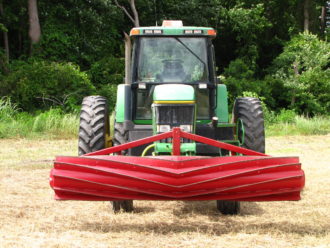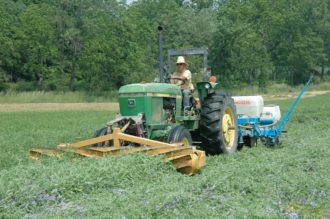It all began in 2002 with a $6,500 SARE grant and the seed of an idea. Today, that idea has grown into hundreds of research projects around the country, an international business and a new, effective no-till tool that farmers are adding to the ways they suppress weeds in cash-crop fields.
The tool is the roller crimper, a drum with blades mounted to the front- or back-end of a tractor and used to roll down, crimp and kill cover crops, creating thick, weed suppressing mulch. Until the crimper, farmers were largely left with two weed-control options: cultivate the weeds into submission or spray herbicides. The former disturbs the soil and allows for erosion; the latter is often expensive for conventional farming, and unusable for organic.
“I had the idea for the tool,” says Jeff Moyer, director of farm operations at the Rodale Institute in Kutztown, Penn. “But without SARE’s help, it might not have happened. That first grant started a whole tidal wave of looking at cover crops differently and it allowed us to build the very first roller crimper.”
Today, the roller crimper is a common sight on land-grant university research plots, according to Moyer, who leveraged that first SARE grant into a larger USDA grant to further refine the tool. One Pennsylvania company, I&J Manufacturing, saw opportunity in the burgeoning technology and now has a thriving business building and shipping roller crimpers domestically and overseas.
Farmers across the country are starting to add the tool to their arsenal of weed control options. Kentucky farmer Joel Armistead, who is collaborating on an EPA-funded project with the nonprofit Cumberland River Compact to explore ways to reduce chemical inputs, says while he ran into problems with the weather, he was able to reduce his spraying considerably by first using the crimper and then spraying just enough to take down the rest of the cover crop.
SARE is continuing to fund other crimper research around the country to explore how the tool works in different climates, geography, and with different cash and cover crops. The crimper, while not a fix-all, has shown promise in using about 40 percent less energy than cultivating or spraying; reducing erosion; retaining moisture; and allowing for more flexibility, since roll downs do not need to be timed to dry conditions.
Tim Bock, who runs a 100-acre certified organic farm outside Kutztown, has tried the roller on more than 20 acres for another SARE-funded project. After two years of success, he plans to completely switch his soybean production to rolled rye. “The results have been outstanding,” Bock says. “I’ve really reduced my weed pressure and drastically reduced the number of trips across the field. I eliminated a complete tillage cycle.”
Moyer cautions that roller crimpers are not for farming 101. A farmer must be quite experienced with the nuances of their fields and work on rotations that match cover crops to the cash crop. “One must grow the cover crop with the same attention paid to the cash crop.”
Want more information? Visit SARE's database of projects and search for the term "roller crimper."

